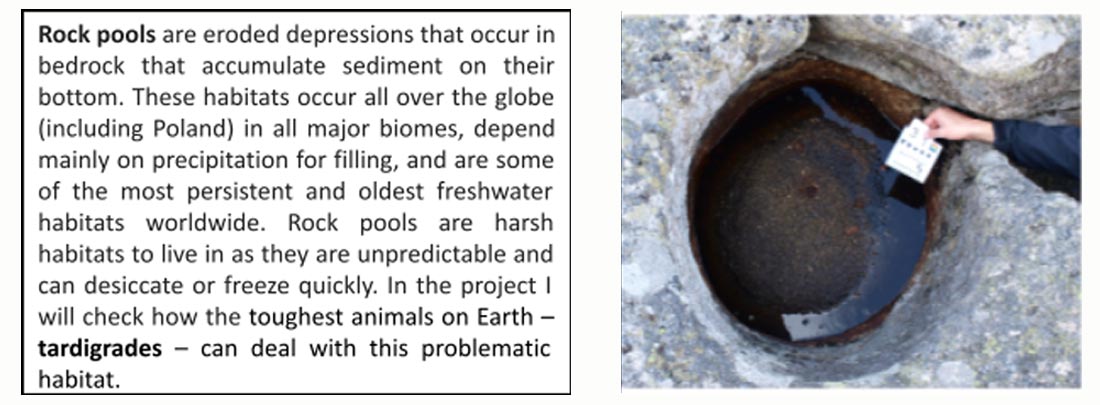
Acronym: META-TAR
Principal Investigator: Matteo Vecchi (m.vecchi@isez.pan.krakow.pl)
Mentor: Daniel Stec (daniel.stec@isez.pan.krakow.pl)
Location: Institute of Systematics and Evolution of Animals Polish Academy of Sciences in Kraków, Poland

Summary
Understanding how habitat desiccation influences the animal communities is fundamental in today’s changing word and a detailed knowledge of their tolerance limits will help in forecasting the effects of global change. Natural ecosystem can be studied;however, they are extremely complex and as such challenging for researchers.

In this project, I will study how many and what tardigrades live in Polish rock pools and how they react to multiple desiccation-hydration cycles and compare the results with similar data obtained for Italian rock pools. I will use a metabarcoding approach which is a molecular technique that allows to sequence a small fragment of gene of

I will be interested in how the environmental conditions of the rock pools determine what tardigrade species and how many individuals can colonize them. I will also study how tardigrades disperse between rock pools and whether the distance between them is important.
Tardigrades do not live alone in rock pools, but share their habitat with some predators,
This project will allow to advance our understanding of how animal communities
By describing the diversity of the fauna from rock pools, this project will also provide information useful to plan conservation strategies for this unique and overlooked habitat that is home to likewise unique and charismatic animals.
Location
Institute of Systematics and Evolution of Animals
Polish Academy of Sciences
Sławkowska 17
31-016, Kraków, Poland
Contact
Matteo Vecchi
m.vecchi@isez.pan.krakow.pl
Institute of Systematics and Evolution of Animals
Polish Academy of Sciences
Sławkowska 17
31-016, Kraków, Poland
Project outputs (updated on 24/03/2025):
Papers published:
Vecchi, M., & Stec, D. (2024). Mitogenome of a new Ramazzottius species (Tardigrada: Eutardigrada: Ramazzottiidae) discovered in rock pools along with its temperature and desiccation-related proteins repertoire. Organisms Diversity & Evolution.htps://doi.org/10.1007/s13127-024-00662-x
Vecchi, M., Stec, D., Rebecchi, L., Michalczyk, Ł., & Calhim, S. (2023). Ecology explains anhydrobiotc performance across tardigrades, but the shared evolutionary history maters more. Journal of Animal Ecology, 93(3), 307 - 318. htps://doi.org/10.1111/1365-2656.14031
Presentations to congresses:
Vecchi M., Godziek J., Ferrari C., Fontaneto D., Stec D. (2024). Tardigrades biodiversity in Italian rock pools revealed trought metabarcoding. 83° Congresso dell’Unione Zoologica Italiana (Pisa, Italy, 11th-14th September 2024). p. 120. Oral presentation
Vecchi M., Camarda D., Ferrari C., Lisi O., McDaniel J., Walsh E. (2023). Freshwater rock pools: an unexplored